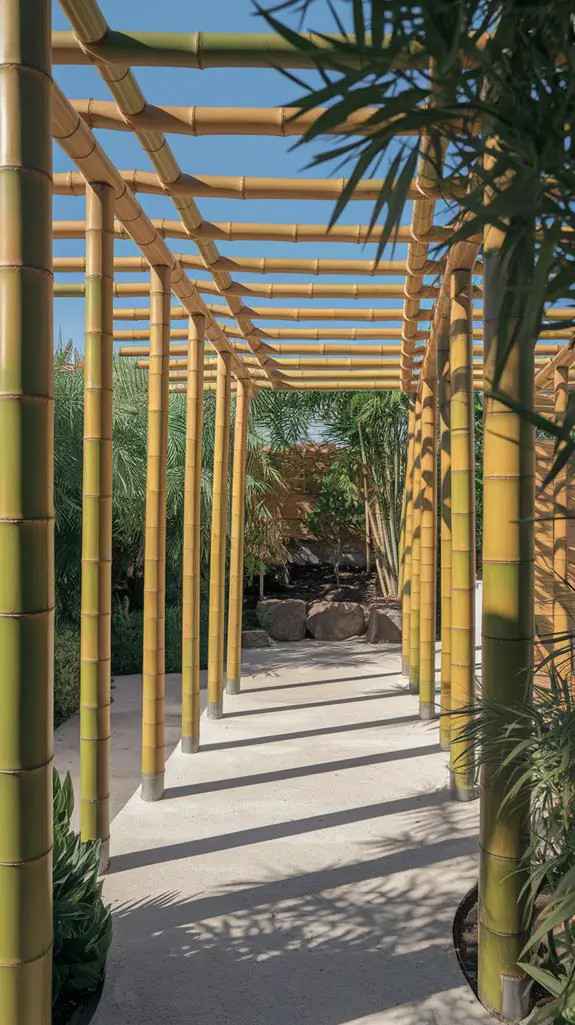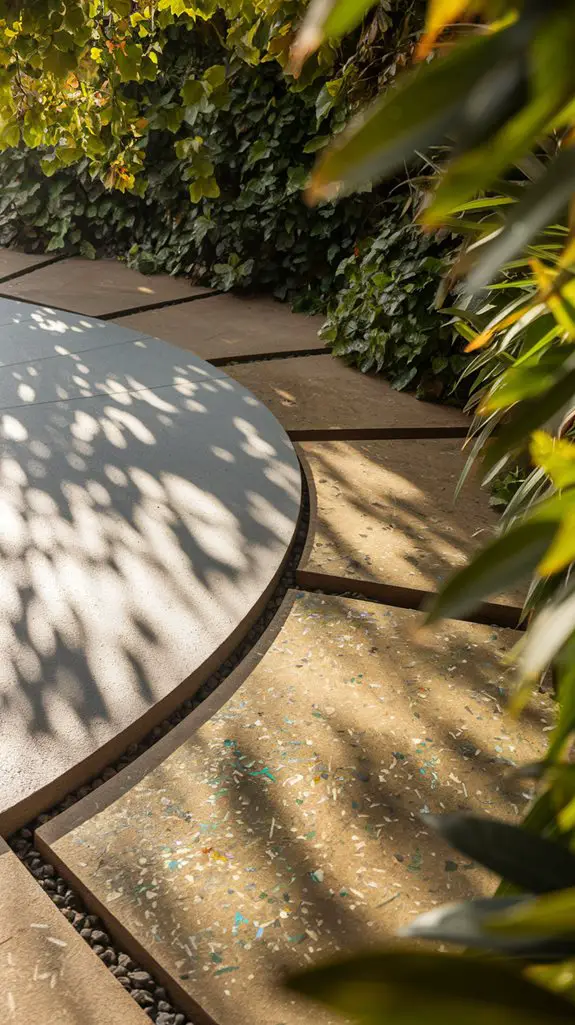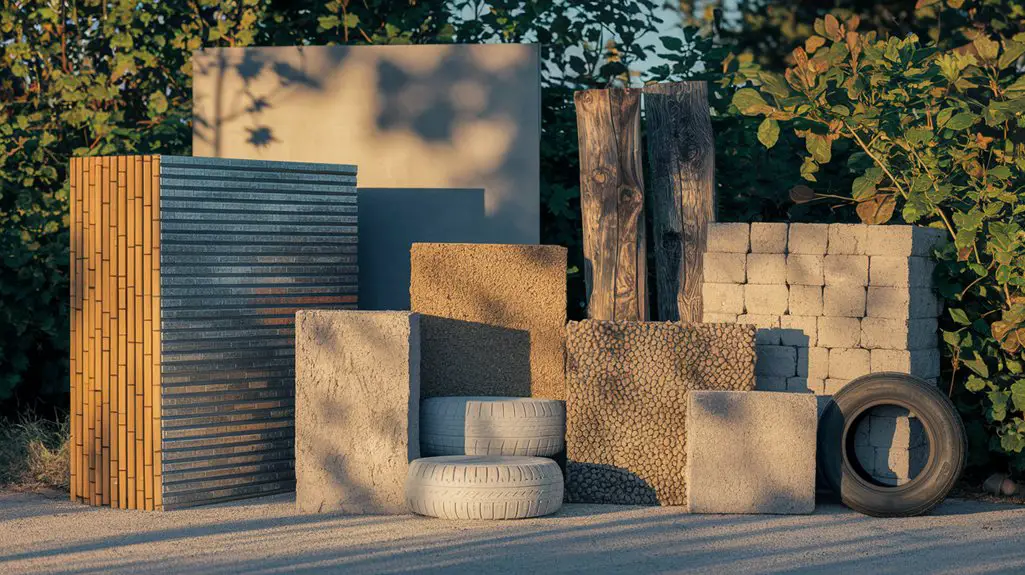While eco-friendly materials might seem more expensive upfront, they often deliver greater long-term value through durability and reduced environmental impact. You’ll find that sustainable outdoor projects not only enhance your property’s aesthetic but also minimize your ecological footprint. The right materials can withstand harsh weather conditions while requiring less maintenance than conventional options. Let’s explore seven materials that balance performance with planet-conscious principles.
Reclaimed Wood: A Rustic Choice for Decks and Garden Features
When examining sustainable materials for outdoor construction, reclaimed wood stands out as a premier eco-friendly option with significant environmental benefits. By repurposing timber from old barns, factories, and warehouses, you’re diverting valuable resources from landfills while reducing demand for virgin lumber harvesting.
You’ll find reclaimed wood offers superior durability, as these aged materials often come from old-growth forests with denser grain patterns than modern equivalents. The natural weathering creates unique patinas and textures impossible to replicate artificially.
For deck construction, consider using reclaimed oak or redwood for their natural resistance to rot and insects. In garden applications, repurposed barn wood makes excellent raised beds, while salvaged fence posts can transform into striking decorative elements.
The dimensional stability of these materials—having already completed their shrinking and warping cycles—ensures your outdoor projects remain structurally sound for decades. Additionally, eco-friendly options like reclaimed wood help promote sustainable practices in construction and landscaping.
Bamboo: Fast-Growing and Versatile for Outdoor Structures

Bamboo represents one of nature’s most remarkable renewable resources for outdoor construction projects, growing at astonishing rates of up to 3-4 feet per day in ideal conditions.
This rapid growth cycle means you’ll harvest bamboo in 3-7 years, compared to 10-50 years for traditional timber species.
When selecting bamboo for outdoor structures, choose properly treated varieties.
Modern preservation methods include pressure-treating with borates or carbonization to prevent insect infestation and decay.
You’ll find bamboo particularly suitable for pergolas, privacy screens, and garden furniture due to its flexibility and tensile strength—exceeding that of steel by weight.
The material’s natural silica content provides inherent water resistance, though applying a UV-protective sealant will extend its lifespan considerably in exposed conditions. Additionally, bamboo’s sustainable characteristics make it an excellent choice for renewable resources in landscaping, promoting eco-friendly practices in your outdoor projects.
Recycled Composite Materials for Durable Patios and Walkways

While traditional patio materials like concrete and natural stone dominate landscaping choices, recycled composite materials have emerged as superior alternatives that combine environmental benefits with exceptional durability.
These engineered products, typically made from recycled plastics and wood fibers, offer resilience against weather exposure without chemical treatments.
- Composition: Manufactured from 90%+ post-consumer waste including plastic bags, milk jugs, and sawdust that would otherwise enter landfills.
- Longevity: 25-50 year lifespan, outlasting pressure-treated lumber by 15+ years with minimal maintenance.
- Performance: Resistance to moisture absorption prevents warping, cracking, and fungal degradation common in organic materials.
- Installation efficiency: Modular systems with tongue-and-groove connections reduce installation time by up to 30% compared to traditional materials.
You’ll find these materials in various textures and colors that mimic natural wood while avoiding deforestation impacts.
Cork: The Underrated Material for Outdoor Flooring and Furniture
Cork stands as one of the most sustainable yet underutilized materials in outdoor design applications, offering remarkable environmental credentials alongside practical performance benefits. Harvested from the bark of cork oak trees without killing them, this renewable resource regenerates every 9-12 years, sequestering carbon throughout its lifecycle.
You’ll find cork excels in outdoor settings due to its natural water resistance, fire-retardant properties, and impressive thermal insulation. When treated with non-toxic sealants, it withstands UV exposure and moisture fluctuations effectively. Additionally, integrating cork into designs can complement sustainable backyard designs that utilize rainwater systems for enhanced eco-friendliness.
Its cellular structure provides natural cushioning underfoot while offering superior noise dampening qualities for deck and patio applications. Additionally, cork’s antimicrobial properties resist mold and mildew growth—a vital advantage in humid outdoor environments.
Hemp-Based Building Products for Garden Beds and Sheds
Hemp-based building materials have emerged as revolutionary options for eco-conscious gardeners and DIY enthusiasts seeking sustainable alternatives for outdoor structures.
Hempcrete, hurds, and fiber composites offer exceptional durability while sequestering carbon throughout their lifecycle.
- Hempcrete blocks – Lightweight, insulative material combining hemp hurds with lime binder, creating breathable, pest-resistant garden shed walls that regulate humidity naturally.
- Hemp fiber insulation – R-value comparable to fiberglass without harmful chemicals, ideal for insulating tool sheds and greenhouse structures.
- Hemp-lime renders – Protective exterior coatings that resist mold while allowing moisture transmission, extending wooden structure lifespans.
- Hemp composite decking – Weather-resistant alternative to traditional lumber for raised beds, combining hemp fibers with recycled plastics for superior rot resistance.
Natural Stone: Local Sourcing for Sustainable Landscaping
Although often overlooked in sustainability discussions, natural stone represents one of our most enduring and environmentally sound materials for outdoor projects when sourced locally.
Unlike manufactured alternatives, local stone requires minimal processing energy and produces zero VOCs or chemical leaching.
When sourcing stone, prioritize quarries within a 100-mile radius to dramatically reduce transportation emissions—typically the largest component of stone’s carbon footprint.
You’ll find that regional varieties like limestone, sandstone, and granite often blend seamlessly with your local ecosystem, enhancing biodiversity and natural drainage patterns.
Consider stone’s exceptional lifespan—potentially centuries—when calculating its environmental impact.
This longevity, combined with stone’s thermal mass properties for temperature regulation, makes it an outstanding choice for sustainable landscape features like retaining walls, pathways, and decorative elements.
Additionally, using natural stone for pathways can help support eco-friendly garden paths, providing a durable and aesthetically pleasing surface that blends harmoniously with nature.
Mycelium Composites: Innovative Fungus-Based Materials for Garden Elements
While traditional building materials dominate the landscaping industry, mycelium composites are emerging as revolutionary alternatives that combine sustainability with surprising structural properties.
These fungus-based materials leverage the natural binding capacity of mushroom root systems to create durable outdoor elements.
- Growth Process – Mycelium spores colonize agricultural waste substrates in 5-7 days, forming solid structures without additional energy inputs.
- Applications – Create planters, garden edging, lightweight furniture, and erosion control barriers.
- Environmental Benefits – 100% biodegradable at end-of-life, carbon-negative production, zero waste manufacturing.
- Performance Metrics – Water-resistant when treated, compressive strength comparable to softwoods, natural fire resistance, and excellent insulation properties.
You’ll find mycelium composites particularly valuable in humid garden zones where their inherent moisture regulation creates healthier plant environments.
Conclusion
By selecting sustainable solutions for your exterior spaces, you’re participating in a powerful paradigm shift. Whether choosing carefully crafted cork, beautiful bamboo, or magnificent mycelium, each material minimizes environmental impact while maximizing functionality. These eco-friendly alternatives reduce resource consumption, decrease carbon footprints, and divert waste from landfills. Your deliberate decisions today drive deeper environmental dividends for future generations—proving pragmatic projects can purposefully protect our planet.




